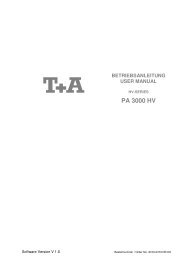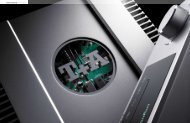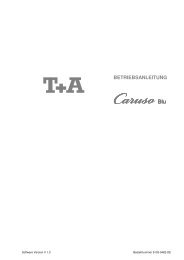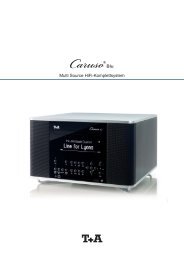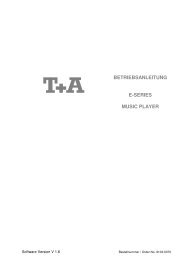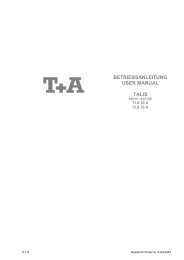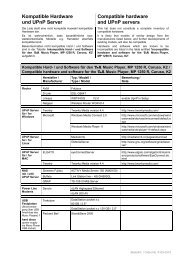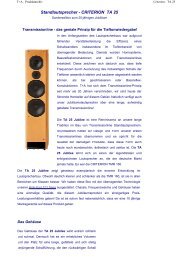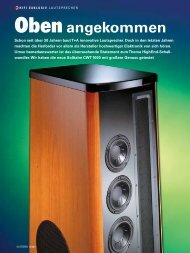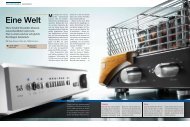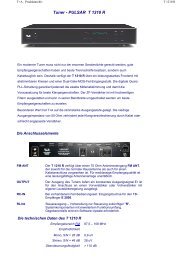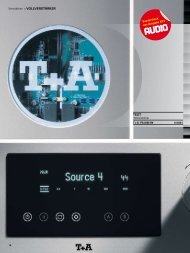CD - SACD - Player - PULSAR SACD 1245 R - T+A Elektroakustik
CD - SACD - Player - PULSAR SACD 1245 R - T+A Elektroakustik
CD - SACD - Player - PULSAR SACD 1245 R - T+A Elektroakustik
You also want an ePaper? Increase the reach of your titles
YUMPU automatically turns print PDFs into web optimized ePapers that Google loves.
<strong>T+A</strong> - Produktarchiv<br />
symmetrical push-pull mode) completely cancels<br />
out equal pulse errors, halves uncorrelated<br />
converter errors, and reduces uncorrelated<br />
background noise by 3 dB. The quadruple<br />
converter features twice the number of converters,<br />
i.e. there are now four converters per channel.<br />
This reduces uncorrelated converter errors to one<br />
quarter, and background noise by 6 dB. The effort<br />
invested in this converter layout is immense, but<br />
the results are worthwhile!<br />
Of course, we use a freely programmable signal processor, so the player still features the<br />
switchable oversampling algorithms for <strong>CD</strong> playback for which <strong>T+A</strong> is renowned, i.e. the<br />
listener can select the best possible reproduction to suit his personal taste, according to<br />
the quality and mix of the disc material. For SA<strong>CD</strong> playback our engineers have also<br />
developed oversampling and noise-shaper circuits which can be switched to four different<br />
modes, generating curves of different gradient and secondary wave suppression. These<br />
circuits make it possible to carry out highly effective fine-tuning to match the sound<br />
characteristics of the chain connected to the player. After the conversion section comes<br />
an extremely sophisticated audiophile analogue output section of discrete construction.<br />
To prevent any danger of the digital section influencing the analogue section, these two<br />
sub-assemblies are separated and de-coupled completely using a unique <strong>T+A</strong> circuit<br />
design. The control signals are transferred via opto-couplers, while the latest jitter-free<br />
magnetic iCouplers from Analog Devices are employed to cope with the high-speed data<br />
signals. The overall result is that the machine achieves genuine analogue High-End<br />
sound quality both with <strong>CD</strong> and also with SA<strong>CD</strong>.<br />
Bandwith switching<br />
The DSD process used for SA<strong>CD</strong> inevitably generates increased background noise in the<br />
region above about 40 kHz. Not all amplifiers can cope with this layer of high-frequency<br />
noise. In the simplest case the amplifier simply becomes very warm, but in many cases the<br />
amplifier also generates intermodulation effects or other distortion products, and these can<br />
have an adverse and extremely disturbing effect in the audible frequency range. One<br />
solution for us would have been to limit the frequency response of the player to the lowest<br />
common denominator, in order to cope with amplifiers of moderate quality, and this would<br />
have been the safe route. However, we were not content with this, so we decided to equip<br />
the SA<strong>CD</strong> <strong>1245</strong> R with a pure analogue output filter which can be switched between 60 kHz<br />
and 120 kHz bandwidth. By this means it is possible to set up the player to match any<br />
amplifier very accurately, and where a good, wide-bandwidth amplifier is used, there is no<br />
need to forfeit anything in terms of frequency response and phase linearity.<br />
Specifications:<br />
Formats<br />
Audio <strong>CD</strong>, <strong>CD</strong>-R / RW, SA<strong>CD</strong>-Stereo<br />
<strong>CD</strong> / SA<strong>CD</strong> - <strong>Player</strong> SA<strong>CD</strong> <strong>1245</strong> R




